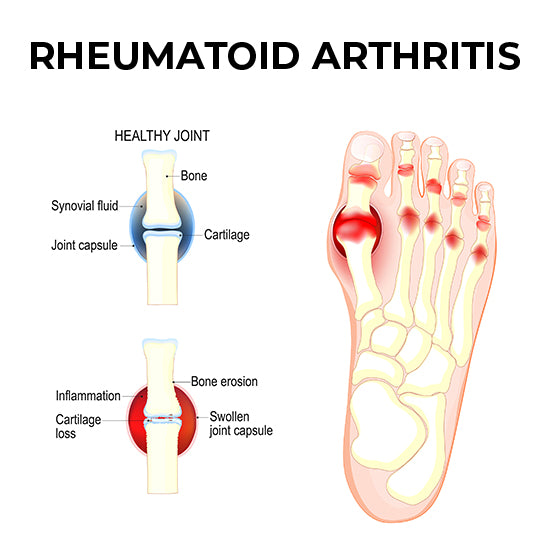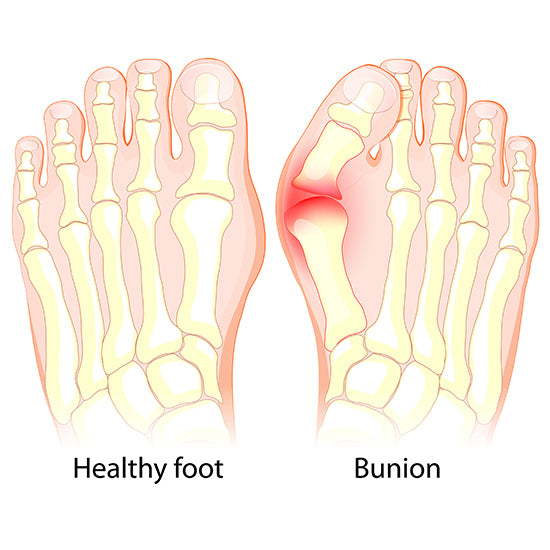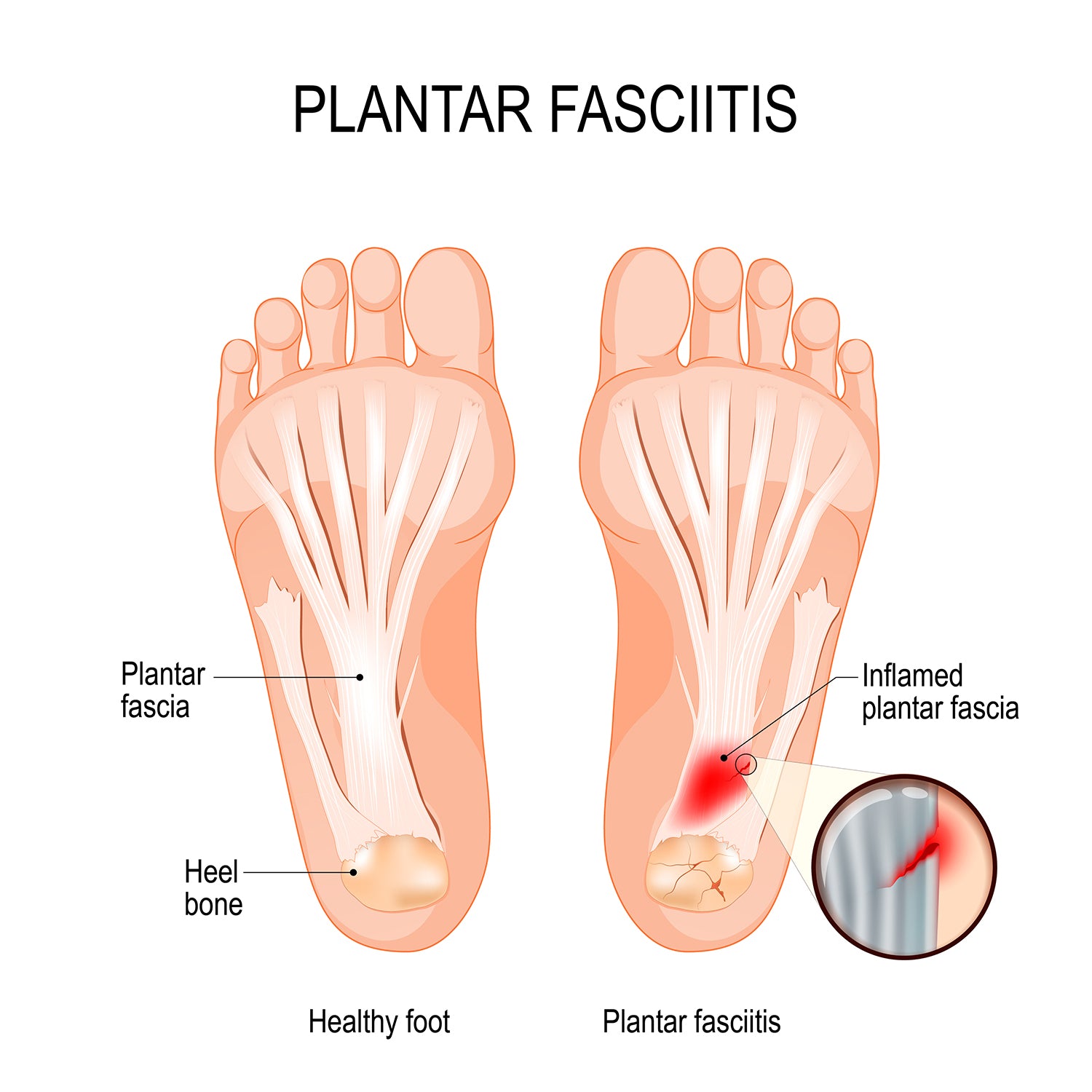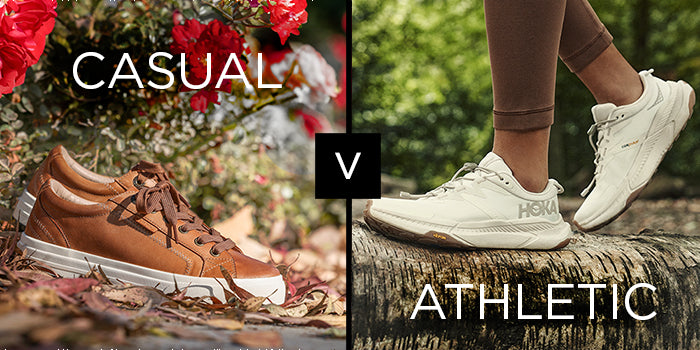
Metatarsalgia is a condition characterized by pain and inflammation in the area just before the toes, medically known as the metatarsal region of the foot. The following list contains several factors that can contribute to the development of metatarsalgia:
- Excessive Pressure: Excessive pressure on the metatarsal heads is one of the primary causes of metatarsalgia, which can result from activities that involve repetitive impact or force on the forefoot. High-impact sports, wearing high-heeled shoes, or being overweight can all increase pressure on the metatarsal area.
- Improper Footwear: Ill-fitting shoes, principally those with narrow toe boxes or inadequate arch support, can force the metatarsal bones into an unnatural position and lead to pain and discomfort over time.
- Foot Abnormalities: High arches or flat feet and other structural issues with the feet can redistribute pressure unevenly across the metatarsal region, making it more susceptible to inflammation and pain.
- Overuse and Repetitive Stress: Engaging in activities that involve excessive running, jumping, or walking on hard surfaces can strain the metatarsal area and lead to metatarsalgia, particularly when the body is not given sufficient time to recover.
- Age-Related Changes: As we age, the fat padding on the soles of our feet can thin out, providing less cushioning to the metatarsal bones. This can make older individuals more prone to developing metatarsalgia.
- Inadequate Foot Mechanics: Uneven pressure distribution from poor biomechanics, such as those that cause overuse of certain muscles in the foot or abnormal gait, can cause metatarsal pain.
- Injuries: Stress fractures or ligament sprains and other trauma or injuries to the foot can lead to metatarsalgia as they disrupt the normal mechanics of the foot.
- Medical Conditions: Certain medical conditions like arthritis, gout, or diabetes can increase the risk of metatarsalgia due to their impact on joint and tissue health.
- Tight Muscles and Tendons: Tightness in the calf muscles or Achilles tendon can alter the mechanics of the foot, potentially increasing pressure on the metatarsal area.
- Inappropriate Footwear During Athletic Activities: Using improper footwear while engaging in sports or physical activities can lead to metatarsalgia. It is important to wear appropriate athletic shoes that provide adequate cushioning and support.
To manage and prevent metatarsalgia, it's essential to address the underlying causes, which often involve a combination of factors. This may include choosing proper footwear, maintaining a healthy weight, practicing good foot hygiene, and seeking medical advice and treatment when necessary.
THREE BIOLOGICAL CAUSES OF METATARSALGIA
1. Primary Metatarsalgia: The 2nd metatarsal—2nd toe—is usually much longer than the first metatarsal—big toe—which may increase pressure and lead to an overload of the affected metatarsal. The increased pressure under the head of the 2nd and 3rd metatarsal will result in thickened skin on the sole of the foot.
Other pre-existing hindfoot deformities that may cause Metatarsalgia are high arches and bunions.
2. Secondary Metatarsalgia: This condition occurs when increased pressure on the metatarsal joints is caused by metabolic conditions like .
- In Rheumatoid Arthrit, the plantar pad—the thick flesh under the heads of the metatarsal) can move away—reducing the amount of soft tissue to cushion the bones. Due to the decrease in the amount of soft-tissue coverage on the heads of the metatarsals, it becomes painful when one bears weight.
- Gout can cause secondary metatarsalgia several ways:
- Uric Acid Crystal Deposition: In gout, uric acid levels in the blood become elevated, leading to the formation of urate crystals. These crystals can be deposited in various joints, including those in the foot. When urate crystals accumulate in the metatarsophalangeal joints of the foot—the joints connecting the metatarsal bones to the phalanges—they can trigger intense inflammation and pain. This inflammation can extend to the surrounding soft tissues, including the metatarsal area.
- Inflammation and Swelling: The presence of urate crystals in the MTP joints can cause acute inflammation. This inflammation results in pain, swelling, and redness in the affected joint. As the MTP joints are in the ball of the foot, this inflammation can directly contribute to metatarsalgia.
- Reduced Mobility and Weight-Bearing Issues: The pain and inflammation associated with gout can lead to a reluctance to bear weight on the affected foot. This can result in altered gait and increased pressure on other areas of the foot, including the metatarsal heads. Over time, these altered biomechanics can contribute to metatarsalgia.
- Tophi Formation: In advanced cases of gout, urate crystals may form lumps called tophi. Tophi can develop in and around the affected joints, including the foot. When tophi occur in the metatarsal area, they can cause mechanical pressure on the surrounding tissues, leading to metatarsalgia.
- Joint Damage: Chronic and recurrent gout attacks can lead to joint damage and deformities. Over time, this joint damage can affect the alignment and function of the foot, potentially causing metatarsalgia.
3. Iatrongenic Metatarsalgia: Blames medical intervention for the development of Metatarsalgia. For example, surgery to correct bunions often involves the shortening of the first metatarsal. This can be shaved too short, resulting in a shift in pressure onto the metatarsals in the middle of the foot, causing metatarsalgia in these areas.
Tips to treat Metatarsalgia:
- Wear orthotics with metatarsal support.
- Avoid ill-fitting shoes with narrow toe boxes.
- Stretch your calves.
- Rest
*We are not doctors, and the information provided here is only meant for informational purposes, not diagnosis. If you suspect you have a foot condition, please talk to your doctor so they can discuss the best solution for you.
]]>


 Also known as calcaneal spurs, heel spurs are bony growths that develop on the underside of the heel bone. They typically form in response to long-term strain or inflammation of the plantar fascia, a thick band of tissue that runs along the bottom of the foot and connects the heel bone to the toes. Several factors can contribute to the development of heel spurs:
Also known as calcaneal spurs, heel spurs are bony growths that develop on the underside of the heel bone. They typically form in response to long-term strain or inflammation of the plantar fascia, a thick band of tissue that runs along the bottom of the foot and connects the heel bone to the toes. Several factors can contribute to the development of heel spurs:

 A common and often painful condition, plantar fasciitis affects the bottom of the foot, particularly the heel area. It occurs when the plantar fascia, a thick band of tissue that connects the heel bone to the toes and supports the arch of the foot, becomes inflamed or strained. There are several factors that can contribute to plantar fasciitis, including:
A common and often painful condition, plantar fasciitis affects the bottom of the foot, particularly the heel area. It occurs when the plantar fascia, a thick band of tissue that connects the heel bone to the toes and supports the arch of the foot, becomes inflamed or strained. There are several factors that can contribute to plantar fasciitis, including:











